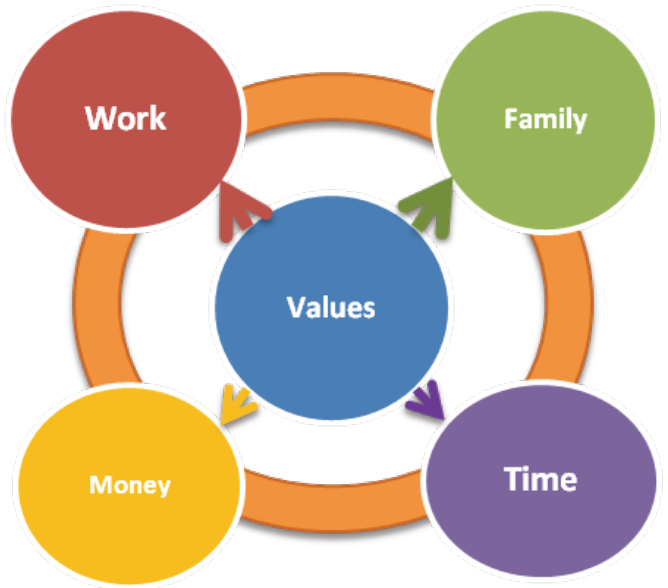A Coaching Model Created by Ann Herd
(Life Strategies Coach, UNITED STATES)
The DAVA model of coaching focuses on work life balance. It is a model specifically geared for coaching clients who are interested in enhancing their work life balance. The DAVA model acronym is based on the following definition of work life balance:
In the DAVA model, balance is achieved when the client realizes their actions each day are aligned with their core values. In the graphic representation of this model depicted above, the client’s core values are at the center of the model. Arrows pointing away from the central “Values” circle depict the idea that the client’s core values are the drivers of daily decisions. The values serve as the primary motivating factors, or drivers, of decisions about work, family, time, and money. These outer circles of “Work,” “Family,” “Time,” and “Money” represent the major categories that many clients find most important in defining their own personal awareness of “work life balance” (Merrill & Merrill, 2003). The underlying circle connecting the four components of work, family, time, and money suggests that these four components are inherently connected and dynamic; decisions about each component’s relative importance and weighting may change during certain points of a person’s life.
A key feature of the DAVA model is that “work life balance” will be unique for each person. The model contains no underlying assumption that a person must devote equal amounts of energy to work or family; rather, each person’s core values dictate what “balance” means to them. For example, if a client’s values all center around work, then balance and alignment would be achieved by that client’s focusing most of their time and energy in work.
To use the model, the coach may use powerful coaching tools to first help the client identify their core values regarding work and family, as well as their personal definition of “work life balance” and how it would feel for their values to be fully “aligned” with their day-today actions. The coach may help the client diagnose the extent to which their day-to-day decisions about how they spend their time and money are aligned with their core values regarding work and family, and then help the client identify positive steps to achieving greater daily alignment between their values and their actions. The DAVA model is useful in focusing on a specific definition of “balance” as being the daily alignment between values and actions.
There is no assumption or judgment about what balance should look like; rather, the model acknowledges that balance will be unique for each person. With this model, the client is successful in achieving balance when their core values about their work and family are aligned with their daily decisions about how they spend their time and money.
References:
Merrill, A. R. & Merrill, R. R. (2003). Life Matters: Creating a Dynamic Balance of Work,
Family, Time, & Money. New York, NY: McGraw-Hill.
